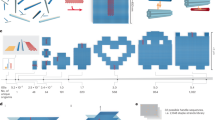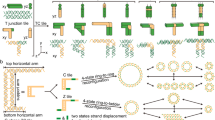Abstract
A central challenge in nanotechnology is the parallel fabrication of complex geometries for nanodevices. Here we report a general method for arranging single-walled carbon nanotubes in two dimensions using DNA origami—a technique in which a long single strand of DNA is folded into a predetermined shape. We synthesize rectangular origami templates (∼75 nm × 95 nm) that display two lines of single-stranded DNA ‘hooks’ in a cross pattern with ∼6 nm resolution. The perpendicular lines of hooks serve as sequence-specific binding sites for two types of nanotubes, each functionalized non-covalently with a distinct DNA linker molecule. The hook-binding domain of each linker is protected to ensure efficient hybridization. When origami templates and DNA-functionalized nanotubes are mixed, strand displacement-mediated deprotection and binding aligns the nanotubes into cross-junctions. Of several cross-junctions synthesized by this method, one demonstrated stable field-effect transistor-like behaviour. In such organizations of electronic components, DNA origami serves as a programmable nanobreadboard; thus, DNA origami may allow the rapid prototyping of complex nanotube-based structures.
This is a preview of subscription content, access via your institution
Access options
Subscribe to this journal
Receive 12 print issues and online access
$259.00 per year
only $21.58 per issue
Buy this article
- Purchase on Springer Link
- Instant access to full article PDF
Prices may be subject to local taxes which are calculated during checkout



Similar content being viewed by others
References
Hata, K. et al. Water-assisted highly efficient synthesis of impurity-free single-walled carbon nanotubes. Science 306, 1362–1364 (2004).
Zheng, M. et al. DNA-assisted dispersion and separation of carbon nanotubes. Nature Mater. 2, 338–342 (2003).
Zheng, M. et al. Structure-based carbon nanotube sorting by sequence-dependent DNA assembly. Science 302, 1545–1548 (2003).
Huang, X., McLean, R. S. & Zheng, M. High-resolution length sorting and purification of DNA-wrapped carbon nanotubes by size-exclusion chromatography. Anal. Chem. 77, 6225–6228 (2005).
Deng, W.-Q., Matsuda, Y. & Goddard, W. A. Bifunctional anchors connecting carbon nanotubes to metal electrodes for improved nanoelectronics. J. Am. Chem. Soc. 129, 9834–9835 (2007).
Cao, Q. & Rogers, J. A. Ultrathin films of single-walled carbon nanotubes for electronics and sensors: a review of fundamental and applied aspects. Adv. Mater. 21, 29–53 (2009).
Piner, R. D., Zhu, J., Xu, F., Hong, S. & Mirkin, C. A. ‘Dip-pen’ nanolithography. Science 283, 661–663 (1999).
Vieu, C. et al. Electron beam lithography: resolution limits and applications. Appl. Surf. Sci. 164, 111–117 (2000).
Chou, S. Y., Krauss, P. R. & Renstrom, P. J. Imprint lithography with 25-nanometer resolution. Science 272, 85–87 (1996).
Wu, W. et al. Sub-10 nm nanoimprint lithography by wafer bowing. J. Am. Chem. Soc. 8, 3865–3869 (2008).
Wang, Y., Maspoch, D., Zou, S. & Schatz, G. C. Controlling the shape, orientation, and linkage of carbon nanotube features with nano affinity templates. Proc. Natl Acad. Sci. USA 103, 2026–2031 (2006).
Diehl, M. R., Yaliraki, S. N., Beckman, R. A., Barahona, M. & Heath, J. R. Self-assembled, deterministic carbon nanotube wiring networks. Angew. Chem. Int. Ed. 41, 353–356 (2002).
Williams, K. A., Veenhuizen, P. T. M., de la Torre, B. G., Eritja, R. & Dekker, C. Nanotechnology: carbon nanotubes with DNA recognition. Nature 420, 761 (2002).
Lyonnais, S. et al. A three-branched DNA template for carbon nanotube self-assembly into nanodevice configuration. Chem. Commun. 683–685 (2009).
Keren, K., Berman, R. S., Buchstab, E., Sivan, U. & Braun, E. DNA-templated carbon-nanotube field effect transistor. Science 302, 1380–1382 (2003).
Hazani, M. et al. DNA-mediated self-assembly of carbon nanotube-based electronic devices. Chem. Phys. Lett. 391, 389–392 (2004).
Bourgoin, J. P. et al. Directed assembly for carbon nanotube device fabrication. Int. Electron Devices Meet. (IEDM '06) 1–4 (2006).
Seeman, N. C. Nucleic-acid junctions and lattices. J. Theor. Biol. 99, 237–247 (1982).
Seeman, N. C. An overview of structural DNA nanotechnology. Mol. Biotechnol. 37, 246–257 (2007).
Robinson, B. H. & Seeman, N. C. The design of a biochip: a self-assembling molecular-scale memory device. Protein Eng. 1, 295–300 (1987).
Pinto, Y. Y. et al. Sequence-encoded self-assembly of multiple-nanocomponent arrays by 2D DNA scaffolding. Nano Lett. 5, 2399–2402 (2005).
Rothemund, P. W. K. Folding DNA to create nanoscale shapes and patterns. Nature 440, 297–302 (2006).
DeHon, A. Array-based architecture for FET-based, nanoscale electronics. IEEE Trans. Nanotechnol. 2, 23–32 (2003).
Dwyer, C. et al. Design tools for a DNA-guided self-assembling carbon nanotube technology. Nanotechnology 15, 1240–1245 (2004).
Avouris, Ph., Chen, J., Freitag, M., Perebeinos, V. & Tsang, J. C. Carbon nanotube optoelectronics. Phys. Status Solidi B. 243, 3197–3203 (2006).
Ke, Y., Lindsay, S., Chang, Y., Liu, Y. & Yan, H. Self-assembled water-soluble nucleic acid probe tiles for label-free RNA hybridization assays. Science 319, 180–183 (2008).
Lu, Y. et al. DNA functionalization of carbon nanotubes for ultrathin atomic layer deposition of high κ dielectrics for nanotube transistors with 60 mv/decade switching. J. Am. Chem. Soc. 128, 3518–3519 (2006).
Jeng, E. S., Barone, P. W., Nelson, J. D. & Strano, M. S. Hybridization kinetics and thermodynamics of DNA adsorbed to individually dispersed single-walled carbon nanotubes. Small 3, 1602–1609 (2007).
Chen, Y., Liu, H., Ye, T., Kim, J. & Mao, C. DNA-directed assembly of single-wall carbon nanotubes. J. Am. Chem. Soc. 129, 8696–8697 (2007).
Li, Y., Han, X. & Deng, Z. Grafting single-walled carbon nanotubes with highly hybridizable DNA sequences: Potential building blocks for DNA-programmed material assembly. Angew. Chem. Int. Ed. 46, 7481–7484 (2007).
Hwang, E.-S. et al. The DNA hybridization assay using single-walled carbon nanotubes as ultrasensitive, long-term optical labels. Nanotechnology 17, 3442–3445 (2006).
Yurke, B., Turberfield, A. J., Mills, A. P., Jr, Simmel, F. C. & Neumann, J. L. A DNA-fuelled molecular machine made of DNA. Nature 406, 605–608 (2000).
Seeman, N. C. De novo design of sequences for nucleic acid structural engineering. J. Biomol. Struct. Dyn. 8, 573–581 (1990).
Vogel, S. R., Kappes, M. M., Hennrich, F. & Richert, C. An unexpected new optimum in the structure space of DNA solubilizing single-walled carbon nanotubes. Chem. Eur. J. 13, 1815–1820 (2007).
Yurke, B. & Mills, A. P. Jr . Using DNA to power nanostructures. Genet. Progr. Evol. Mach. 4, 111–122 (2003).
Panyutin, I. G. & Hsieh, P. Kinetics of spontaneous DNA branch migration. Proc. Natl Acad. Sci. USA 91, 2021–2025 (1994).
Christensen, U., Jacobsen, N., Rajwanshi, V. K., Wengel, J. & Koch, T. Stopped-flow kinetics of locked nucleic acid (LNA)–oligonucleotide duplex formation: studies of LNA–DNA and DNA–DNA interactions. Biochem. J. 354, 481–484 (2001).
Schulman, R. & Winfree, E. Synthesis of crystals with a programmable kinetic barrier to nucleation. Proc. Natl Acad. Sci. USA 104, 15236–15241 (2007).
Barish, R. D., Schulman, R., Rothemund, P. W. K. & Winfree, E. An information-bearing seed for nucleating algorithmic self-assembly. Proc. Natl Acad. Sci. USA 106, 6054–6059 (2009).
Gao, B., Komnik, A., Egger, R., Glattli, D. C. & Bachtold, A. Evidence for Luttinger-liquid behavior in crossed metallic single-wall nanotubes. Phys. Rev. Lett. 92, 216804 (2004).
Fuhrer, M. S. et al. Crossed nanotubes junctions. Science 288, 494–497 (2000).
Bachtold, A. et al. Scanned probe microscopy of electronic transport in carbon nanotubes. Phys. Rev. Lett. 84, 6082–6085 (2000).
Postma, H. W. Ch., de Jonge, M., Yao, Z. & Dekker, C. Electrical transport through carbon nanotube junctions created by mechanical manipulation. Phys. Rev. B 62, R10653–R10656 (2000).
Ahlskog, M., Tarkiainen, R., Roschier, L. & Hakonen, P. Single-electron transistor made of two crossing multiwalled carbon nanotubes and its noise properties. J. Appl. Phys. 77, 4037–4039 (2000).
Park, J. W., Kim, J. & Yoo, K.-H. Electrical transport through crossed carbon nanotube junctions. J. Appl. Phys. 93, 4191–4193 (2003).
Lee, D. S., Svensson, J., Lee, S. W., Park, Y. W. & Campbell, E. E. B. Fabrication of crossed junctions of semiconducting and metallic carbon nanotubes: a CNT-gated CNT–FET. J. Nanosci. Nanotechnol. 6, 1325–1330 (2006).
Kershner, R. J. et al. Placement and orientation of individual DNA shapes on lithographically patterned surfaces. Nature Nanotech. 4, 557–561 (2009).
Rueckes, T. et al. Carbon nanotube-based non-volatile random access memory for molecular computing. Science 289, 94–97 (2000).
Bachtold, A., Hadley, P., Nakanishi, T. & Dekker, C. Logic circuits with carbon nanotube transistors. Science 294, 1317–1320 (2001).
O'Neill, P., Rothemund, P.W. K., Kumar, A. & Fygenson, D. K. Sturdier DNA nanotubes via ligation. Nano Lett. 6, 1379–1383 (2006).
Acknowledgements
This work was supported by the National Science Foundation (CBET/NIRT 0608889; CCF/NANO/EMT 0622254 and 0829951), the Office of Naval Research (N00014-05-1-0562) and the Center on Functional Engineered Nano Architectures (FENA, Theme 2 and Theme 3). P.W.K.R. thanks Microsoft Corporation for support. S.H. thanks Julie Norville for helpful discussions.
Author information
Authors and Affiliations
Contributions
H.T.M., S.H. and R.D.B. conceived of the project, designed the structures, conducted the experiments and took the measurements with advice and consultation from all authors. All authors contributed to writing the paper. M.B., W.A.G., P.W.K.R. and E.W. provided financial support.
Corresponding author
Supplementary information
Supplementary information
Supplementary information (PDF 2001 kb)
Rights and permissions
About this article
Cite this article
Maune, H., Han, Sp., Barish, R. et al. Self-assembly of carbon nanotubes into two-dimensional geometries using DNA origami templates. Nature Nanotech 5, 61–66 (2010). https://doi.org/10.1038/nnano.2009.311
Received:
Accepted:
Published:
Issue Date:
DOI: https://doi.org/10.1038/nnano.2009.311
This article is cited by
-
A guideline for the distance measurement plans of site-directed spin labels for structural prediction of nucleic acids
Journal of Molecular Modeling (2024)
-
Biotemplated precise assembly approach toward ultra-scaled high-performance electronics
Nature Protocols (2023)
-
Site-directed placement of three-dimensional DNA origami
Nature Nanotechnology (2023)
-
Ultrahigh loading dry-process for solvent-free lithium-ion battery electrode fabrication
Nature Communications (2023)
-
A temporally resolved DNA framework state machine in living cells
Nature Machine Intelligence (2023)



